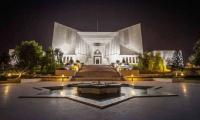ISLAMABAD: The government has announced one of the most populist budgets in the history of Pakistan giving relief to almost all the sectors of the society. Giving populist budget is not a negative point as government is duty-bound to maximise the welfare of citizens. But without an alternate programme to offset the loss of tax revenue that will occur as a result of tax relief, the future government may be in trouble to get revenue and expenditure targets.
The Centre for Peace and Development Initiatives (CPDI’s) instant analysis of federal budget 2018-19 examines that the direct tax relief given to general public is unprecedented in the history of Pakistan. This is a welcome step but no concrete plan has been presented to offset the revenue loss as a result of this tax relief. Although no data is provided, it is estimated that nearly half of the one million active tax payers will be out of the list as taxable income has increased from Rs400000 to Rs1200000. The measures like barring non-filers to purchase property of more than 4 million may not result in to increase of horizontal tax-base in Pakistani environment. The FBR will have to work more diligently and scientifically to not only offset the apparent loss in revenue but also to achieve the 13% enhanced targets as compared to last year.
The last four year trends show that reliance on foreign assistance is always increased in revised estimates as compared to budget estimates. These budget estimate figures for foreign assistance are kept on lower side to avoid criticism. During FY 2015-16, the difference between budget estimates and revised estimates was 10.89%. During the subsequent two years, the difference was as high as 21% and 46%. The budget estimates for foreign assistance for the FY 2018-19 are Rs1118023 million and the prorate figures would be Rs1632313 million. With the proposed tax relief, and no concrete plan for increasing tax net, these figures can be even high.
Despite high claims of transparency and accountability, the federal government has failed to take practical steps in right direction. One such example is the establishment of Pakistan Information Commission. The commission is an appellate body to be established under Right of Access to Information Act, 2017 that was enacted in October last year. The due date for the establishment of commission has already elapsed and there are no such indications from the government to establish the commission. The absence of any budget allocations for the said commission indicates that government has no planning to establish the commission in next year.
CPDI’s instant analysis of federal budget 2018-19 examines (a) transparency of projects (b) geographic share of Development Projects and (c) analysis of supplementary projects 2017-18. The analysis clearly declares 21% of development projects as non-transparent; where the project details i.e geographical area, budget allocation to specific heads etc. are not clearly mentioned. Secondly, analysis of geographic share of development projects shows an interesting data where 10.85% of total projects are allocated in Punjab, with the cost of 11.37% of total development budget. 13.5% of projects are allocated in Sindh, with the cost of 14.47% of total development budget. 11.16% of projects are planned in KP with the cost of 9.94% of total development budget. Lastly, major portion of 19.75% of total projects is allocated in Balochistan, with the lesser cost of 4.85% of total development budget. Maximum projects are allocated for the province of Balochistan although total cost of projects allocated in Punjab is the highest.
According to new water policy the government will enhance allocation on water resources to 10% of total development budget. The allocations will be increased to 20% by the year 2030. The analysis of budget shows that this benchmark is still far from being achieved. Total allocation for Ministry of Water Resources in 2018-19 budget is Rs62026.495 million that is 5.4% of total development budget.
The 100-100-100 dream of federal government may not be realised with the current allocation to the education sector. The budget estimates for primary education for FY2018-19 are Rs2034 million which are only 10% higher than last year revised estimates of Rs1843 million. The allocations for primary and secondary schools have been done in blocks which are a non-transparent way of making budget. Further, with the proposed allocations, it would not be possible to run the affairs of primary and secondary schools efficiently. Studies have shown that there is an urgent need of at least 30% increase in the non-salary current budget to efficiently run the affairs of primary and secondary schools under the federal government. The big chunk of proposed 10% increase in education budget will be required to accommodate 10% increase in salary and little amount will be left to increase non-salary current budget. The operating expenses are increased by 2.7% only when compared to the revised estimates of the last year. There has been a drastic decrease in budget allocation to physical assets for primary schools. As against the last year’s revised estimates of Rs9.7 million, this year’s proposed allocation is Rs573000 million only which shows a decrease of 94%.
The budget allocation for secondary education (middle schools) is not much different from the primary schools allocation trends. The proposed budget for the FY 2018-19 is Rs637 million which is 15% higher than the last years revised estimates of Rs556 million. Here again, the biggest increase is in employee-related expenses that shows 19% increase. Operating expenses for the middle schools have been reduced by 4% from 111 million in FY 2017-18 to 107 million in FY 2018-19. Similarly, purchase of physical assets has shown a decrease by 94%.
The proposed budget for secondary education (high schools) has shown an increase from Rs1752 million in FY 2017-18 to Rs2135 million in FY 2018-19 which is 22% higher. Here again the biggest jump is in employees related expenses that increased from Rs1434 million in FY 2017-18 to Rs1811 million in FY 2018-19 thus registering an increase of 26%. The previous trend of allocation in operating expenses and physical assets continued for High Schools too. Operating expenses increased by 3% only from revised estimates of Rs279 million for FY 2017-18 to Rs285 million in FY2018-19. The budget allocation for physical assets again showed a downward trend. Rs1.2 million was allocated for FY 2018-19 as against Rs3.55 million which is a decrease of 66%.
While new proposed budget is being widely discussed, the supplementary budget of 2017-18 remains in shadow. There are projects that were planned for year 2017-18 but never executed, hence remained deprived. 39% of total planned projects remained deprived of their share when budget was actually executed. On opposite there are projects that had no allocations in budget estimates 2017-18 but during the year these were implemented. Percentage of such new projects remained 36% of total number of development projects executed in 2017-18.
Petitioner prays apex court to constitute a full court for hearing instant petition
Surge reflects impact of a deregulatory policy introduced earlier this year
Gandapur says govt aims to centralise database of marginalised segments of society
Police immediately transfers injured to hospital and registers case, initiating further investigation
Cache of narcotics was being transported by sea to international destinations







